
First, the RSE's were not colored by Roberts or Haghe, but by anonymous colorists
of varying skill. Some RSE's are exceptionally well done, while others are less
so. Though there is a basic consistency between the coloring of all RSE prints
(Roberts produced a watercolored "model" of each print for the colorists
to work from), there are often surprising minor variations between RSE's of
the same image. Colors were changed, added, or applied to different areas as
the run progressed and individual colorists came and went. The modern coloring
of an SE print, therefore, can be done in the same manner, and with the same
skill and results, as the original RSE version so long as the colorist recreates
the scheme of a particular RSE precisely. A properly colored SE print is thus
no more a "copy" than was the original colored RSE. The lithograpy
of both editions is genuine and identical, and the coloring has been added to
both after printing in the same way. Second, there is a steady (thought dwindling)
supply of genuine un-colored SE prints available to which coloring can be added.
Since it is easy to tell colored SE's from RSE's, due to differences in paper
and titles, there is little opportunity for confusion or misrepresentation as
to whether a particular print is an RSE or a genuine modern hand colored SE.
(For more information on these differences, see How
to Identify Different Editions.)

In the end it is a matter of personal choice, but by far the majority of collectors seem to prefer colored SE prints to uncolored SE prints. In the case of Roberts Prints, the addition of later hand coloring to an SE image does not seem to decrease its value so long as it is done properly. In fact, it seems to increase the value of the image to most collectors and customers.
